
Picture what you think a fitness instructor should look like. Then walk into any big box gym, boutique studio or other fitness facility and compare the instructors to what you had in your mind. Chances are, they’re not the same — and you’re not necessarily alone.
Fitness instructors come in all shapes and sizes. This is logical — they are human, after all! But society pushes us to think they should have a certain build and look depending on what they teach — yoga, barre, indoor cycling or CrossFit.
This bias can hurt them personally as well as professionally. In a 2007 study published in the Journal of Sport Management, Texas A&M University researchers performed three experiments to see how weight discrimination affected whether job applications were hired to teach aerobics classes or be a personal trainer. In all three situations, people who were qualified and overweight were thought to be less ideal for the position than others, even some who were thin yet unqualified for the job.
“There is a standard that we think every trainer is supposed to look like, and if you don’t, you must not be able to deliver results to clients,” says Janis Isaman, owner of My Body Couture, a private, one-on-one studio in Calgary.
Learning how fitness instructors overcame body judgment can help us navigate similar situations and realize there is no one-size-fits-all.
JUDGMENT: “YOU DON’T REALLY LOOK THE PART.”
Response: Do not let anyone define who you are and what you can be.
Students loved Lucie B. Linder’s class. But some began asking the certified group fitness instructor and personal trainer, “How come you look fat?” The comments brought back memories of being teased for having big legs and thighs as a child. So after this happened a few times, she met with a few of the women to explain that trainers come in all shapes and sizes.
The comments stopped, but then Linder began teaching at a high-end gym. “My manager said a lot of people were saying things about my body,” she says. “That some members were scared to take my class for fear of looking like me.” But she kept teaching and after an actor and model attended her class, her classes took off!
Then she moved to Sweden. She wanted to bring her class to a gym there, but she learned from a friend who worked at the gym that they wouldn’t hire her because of her body shape. So she decided to do her own thing, including creating Lucie B Jump N Fun, which teaches kids how to jump rope, and Team Sheroes, a group of women in their 70s that she’s training to become jump rope champions.
Her goal: to empower girls and women of all ages to feel amazing about themselves. “You can do anything you set your mind to,” she says. “If you want to lose weight, do it for you — not because you think you need to fit into a particular role or standard. No matter your weight, shape, size, age — do not let anyone define who you are and what you can be. Just go for it!”
JUDGMENT: “FOR A SKINNY GUY, YOU KNOW WHAT YOU’RE DOING.”
Response: It’s a losing battle to try to always win over others.
When Mike Clancy, certified strength and conditioning specialist, started in the industry, the New York City-based fitness trainer immediately noticed he was the lightest of all the trainers at his gym. “I felt out of place not because of my education, but I felt inadequate as far as the physical presentation of myself,” says Clancy, who carried about 155 pounds on his 6-foot frame.
He noticed that bigger male trainers had more clients and demand. One even told him, “your body is your billboard” when you’re a trainer. When clients made comments like, “For a skinny guy, you really know what you are doing,” Clancy was insulted at first. “I had such a strong education and background with a degree in exercise science, five certifications, 3–5 years’ experience, and a proven track record,” he says. “But they felt I didn’t look the part.”
So Clancy took it as a challenge. He put on more lean mass, reaching an athletic 175–180 pounds, which he now maintains. “My client base and demand went through the roof,” he says. At the same time, he learned how to find balance. When he found himself focusing too much on workouts and diet, he knew he had to step back. “I don’t want my life solely based around health and fitness. It’s an important part of my life, but not the only part,” he says.
To others who want to use body judgment as a challenge, he says to make sure you’re doing it for the right reasons. “There’s always going to be someone who doesn’t like or support how you look or how you do certain things,” he says. “It’s a losing battle to try to always win over others. As you are on a quest to improve your health and wellness?Make sure it’s because you want it for yourself, not for the validation of another person.”
JUDGMENT: “YOU’RE HEAVIER THAN OTHER TRAINERS.”
Response: Everybody has a different perception of what is healthy …
Sheri Traxler, an ACE-certified personal trainer, was working with a new client at a medical fitness facility when he asked if he could ask her something. When she said yes, he replied, “I’ve worked out at some other gyms, and you don’t look like a personal trainer. You’re heavier. Can you explain that?”
Internally, Sheri felt embarrassed — and pissed. “How dare he!” she says. But she kept her professional face on and explained to him not only healthy weight ranges and how healthy looks different on different bodies, but also her personal experience of being anorexic as a teenager and the associated dangers, as well as how she stays away from that mentality now. She could see the light bulbs turning on for him.
“A lot of people don’t know,” she says. “Everybody has a different perception of what is healthy, and for some people they’re going to be a size 4 and have massive amounts of muscle, and some are going to be a size 4 with very little muscle, and others will be size 12 and have average muscles.”
The important thing is to own your body, she says. Don’t let comments affect you and how you decide to live.
JUDGMENT: “THIS GUY’S A TRAINER?”
Response: If someone comments about you, they might be doing it to feel better about themselves.
Mike Donavanik, certified strength and conditioning specialist, a personal trainer based in Los Angeles, publishes workout videos on YouTube and then licenses them to fitness sites. Occasionally a troll on his site will knock him down, posting comments like “You aren’t fit” or “Where are his muscles?” But the comments when other sites pick up his videos can be vicious, he says.
“One that got to me the most was, ‘Why is this guy even on here? He doesn’t look athletic. He shouldn’t be a trainer. Why is he so out of breath?’” Donavanik says. What the commenter didn’t know was that the short clip she saw was from a 10-minute workout, and if you do the full workout, you’d be huffing and puffing by the end, too, he says.
With time, he’s learned not to take these comments personally. “It’s not about me,” he says. “You have to think about what these people are possibly going through that they’d find the time and energy to write something mean about someone they never met and know nothing about.”
READ MORE > ARE ABS WORTH THE HYPE?
Donavanik encourages others to realize that if someone comments about your body, they are just taking their misery out on you to feel better about themselves. He also says to expand your idea of what a trainer looks like. “Drop the thought that a trainer needs to be a sexy image of a goddess or Adonis,” he says. “Having a six-pack isn’t indicative of health. Just because someone doesn’t look like a stereotypical trainer doesn’t mean they aren’t a great trainer. And just because another has the body doesn’t mean they have the knowledge to properly train people.”
Judgment: “YOU LOOK PRETTY WHEN YOU SMILE.”
Response: Pick trainers and instructors based on their philosophy, not their looks.
During a teacher training, Isaman learned that some people care more about how you look, not how you teach. “The feedback the instructor gave me was, ‘You look pretty when you smile,’” she says. “She had an expectation that I should look a certain way, and if I didn’t, I couldn’t teach a client.”
Isaman knows her bone structure doesn’t allow her to do certain poses — but she can still teach those poses. She strives to be authentic on her social media, never touches up photos and doesn’t freak out and think, ‘Oh my gosh, I have a video shoot! I need to lose a few pounds!’ “I’m shooting tomorrow and this is what I look like,” she says.
She encourages people to pick trainers and instructors based on their philosophy, not their looks. “The best yoga instructor I ever had was like a size 8 or 10. She was amazing,” Isaman says. “Instead of looking at a trainer’s body, find out what they do — are they extreme or are they relaxed about their diet and exercise? Take the time to dig in and have a conversation rather than making a snap judgment.”
The post How 5 Fitness Instructors Overcame Body Judging appeared first on Under Armour.
(via MyFitnessPal Blog)





